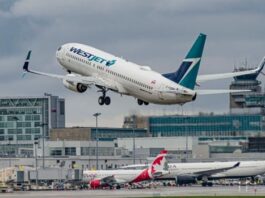
The federal government needs to be more transparent — and ambitious — about its upcoming plan to reduce carbon emissions from the aviation industry, a group of environmental organizations are saying in an open letter.
In the letter, which was released last week, the groups say Canada is falling behind other countries in tackling aviation emissions, and that the federal government needs to impose an emissions reduction target of 30 per cent below 2019 levels on the industry by 2030. They say emissions from the aviation sector have ballooned dramatically — up 74 per cent from 2005 to 2019 — and the previous emissions plan has failed to stem the tide.
The letter was signed by dozens of environmental and heath groups, including Environmental Defence, Équiterre and Registered Nurses’ Association of Ontario.
“And here we have government that’s going to look at the emissions question privately behind closed doors with industry to come up with a plan that has to be presented in September in an international forum,” said Lyn Adamson, co-chair of advocacy group ClimateFast, one of the letter’s signatories, referring to the International Civil Aviation Organization (ICAO).
“We’re just saying that you have to have public input. It has to be a transparent process.”
Air travel accounted for about three per cent of Canada’s total emissions in 2019 (in 2020, air travel dropped dramatically due to the pandemic), or about 22 megatonnes of CO2-equivalent greenhouse gases. That’s equivalent to emissions from five million cars annually.
What’s the plan?
Canada’s aviation emissions reduction plan is slated to come out in the fall and will be submitted to the International Civil Aviation Organization, the UN agency that oversees international air travel and navigation. The ICAO has set aspirational goals of improving fuel efficiency by two per cent annually through 2050, and carbon-neutral growth in the aviation sector from 2020 onward.

The international agency is also developing the Carbon Offsetting and Reduction Scheme for International Aviation (CORSIA), in which Canada is participating. The system will require airlines to offset some of their carbon emissions by buying carbon offsets that reduce emissions elsewhere, a tool that’s controversial due to challenges with verifying whether the offsets work.
Canada’s last aviation emissions plan was released in 2012. It relied on encouraging fuel efficiency, the development of more sustainable fuels that released less carbon when burned, and improvements to air traffic control that could further reduce emissions. It did not contain any short-term emission reductions goals for the industry, something Adamson says should be included this time.
What can be done to cut emissions?
Advocates say it’s time for Canada to look beyond fuel efficiency and start thinking about curbing demand for air travel.
“Short-haul flights in Canada could be replaced by buses and trains, which are certainly better from a climate point of view. So those trips, for example, from Toronto to Ottawa, Toronto to Montreal, we should be doing by bus or train, and ideally by electric bus and electric train,” said Gideon Forman, a transportation policy analyst at the David Suzuki Foundation, which also signed onto the letter.
“It will take some work. I mean, we don’t have fast trains between Toronto and Montreal, Toronto and Ottawa at this point, but we need to be going in that direction.”
Forman says because of Canada’s geography, air travel will remain essential. But a lot of busy routes in the Windsor-Quebec City corridor, or between major cities in B.C. and Alberta, can be replaced by trains and buses, he said.
France is considering something similar. In 2021, it moved to ban domestic flights where a train alternative of two and a half hours exists.
Denmark has announced a goal of reaching net-zero emissions for all domestic flights there by 2030, although that depends on sustainable fuel technologies that don’t exist yet. Airbus, the European aircraft manufacturer, wants to make a zero-emissions plane available commercially by 2035. It would rely on hydrogen, a fuel that does not emit CO2 when burned.

But the rapidly rising demand for air travel is ringing alarm bells for environmental advocates.
“I think what really stands out for us is that they are a growing sector, a fast growing sector,” Forman said.
“Not just in Canada, but internationally, as the middle class grows, more people fly. And so it’s increasingly a worry internationally.”
What is the industry doing?
Air Canada, the country’s largest airline, has set a goal of reaching net-zero emissions across its operations by 2050. It also has a short-term target of a 20 per cent emissions reduction below 2019 levels by 2030 for its flights, something that the open letter highlighted as well.

In an email statement, the airline said it supports the government adopting long-term climate goals for the industry. The company’s climate plan includes replacing older airplanes with more fuel efficient ones and supporting the development of more sustainable aviation fuels (which emit less CO2 when burned than what’s currently used).
Transport Canada said that the new emissions plan “will establish a net-zero vision for aircraft emissions by 2050 as a first step and provide a signal for more work to come.” It did not provide further details about the plan because it is still under discussion.












